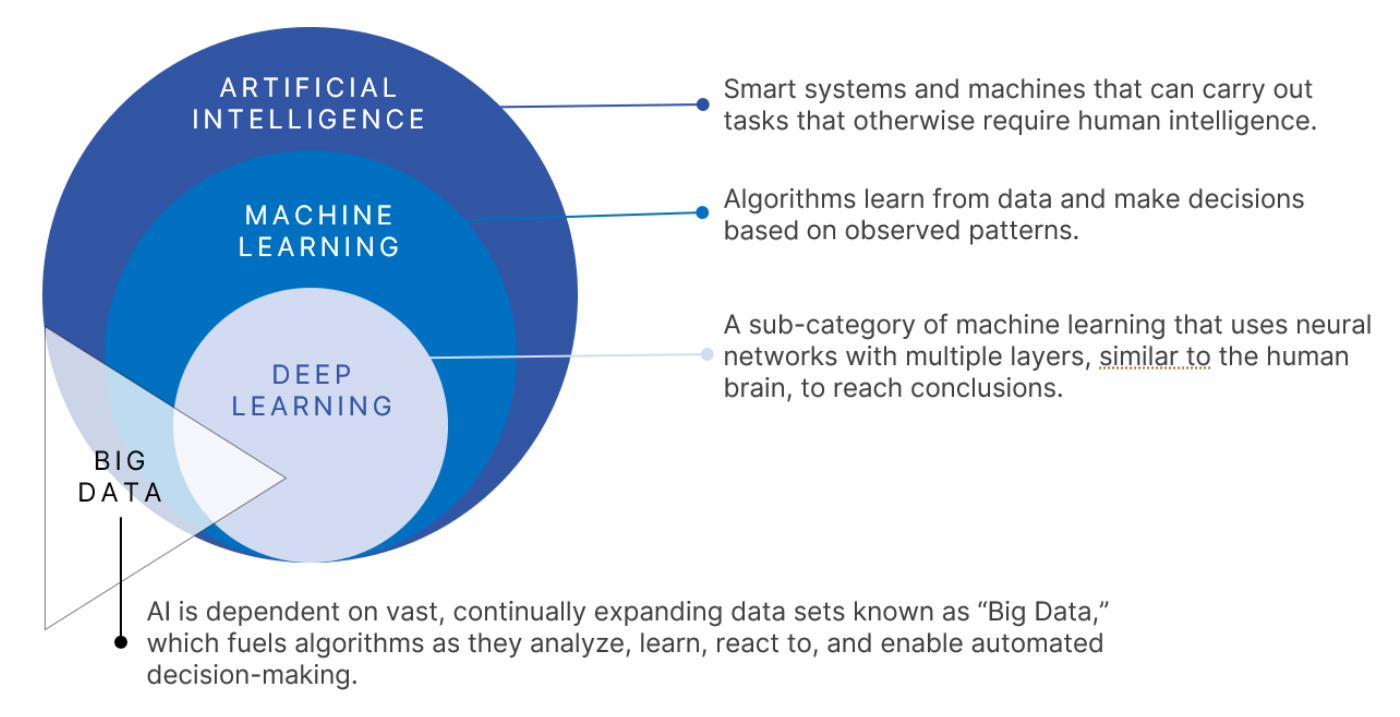How AI is ‘moving mountains’ across the investment landscape
How AI is ‘moving mountains’ across the investment landscape

The ability of artificial intelligence to transform the investment world is an evolution unfolding right now, similar to the way AI has grown in its significant impact on our daily lives over the past decade.
Artificial intelligence (AI) is ubiquitous in our daily lives.
You can now open your phone with face ID, ask Alexa to tell you the weather, navigate to a medical appointment using Google Maps, and receive AI-driven health-care diagnostics … the list goes on and on. Each of these tools, some less than 10 years in use, has been widely embraced by users with little thought to the AI technology powering them.
One area where AI technology has not yet exploded into the mainstream is the investment world. While AI is established in some robo-advisory tools and in back offices for automation and trade execution, it has not been widely adopted for investment research or portfolio construction—an area so ripe with opportunity we believe those who embrace AI tools and techniques will be the ones to “move mountains.”
Mountains of data
Over the years, financial data has become increasingly complex. Today, instead of simply analyzing structured data such as historical stock prices and economic data to construct a financial model, the advent of big data allows one to take into consideration alternative data sets: audio and video clips, blogs, real-time news and weather reports, or flight and shipping information, to name a few.
This makes AI a critical technique to parse the “mountains” of data available for analysis in the pursuit of undiscovered sources of alpha.
Machine learning (ML) is a subset of AI that focuses on learning and adapting from massive data sets without being explicitly programmed to do so. ML uses algorithms and statistical models to analyze and draw inferences from data, but, importantly, this advanced computing capability looks at data and the relationships between data from 360 degrees and on multiple planes. The ability to parse a signal (good) from the noise (bad) can allow ML algorithms to quickly adapt to today’s dynamic markets, potentially giving one a better handle on managing risk, which ultimately can lead to superior performance.

Quant investing 2.0
One of the first questions that comes to mind when discussing AI in an investment strategy is, “Isn’t this just quant investing?” The answer is yes, but in our view, the better question is, “What is the difference between an AI-driven quant strategy (‘AI-driven strategy’) and a quant strategy that applies only traditional statistical techniques (‘traditional quant’)?”
Consider the AI-driven investment strategy to be traditional quant’s younger, smarter, more dynamic sibling: Quant 2.0. Both are attempting to make investment predictions from perceived patterns in data. But quant models that use traditional statistical techniques largely rely on widely available structured data, which provides little competitive advantage. With the exponential growth in unstructured data and advancement in machine learning and computing power, AI-driven models are uniquely positioned to discover meaningful market anomalies and signals at a speed and scale humans alone cannot achieve.
In traditional quant investing, a predefined regression model only knows the historical events and relationships in the structured data on which it was developed. (In general, most “traditional quant” strategies use some form of AI tools and techniques in their investment process, but the extent to which AI is used or incorporated ranges widely. Few quantitative managers explicitly define themselves by a purely AI-driven investment process.)
AI-driven strategies, however, are constantly learning from and adapting to new data—both structured and unstructured—amid evolving market conditions. Machine learning is one AI technique that learns from the complex data it absorbs and dynamically adjusts to enhance its comprehension of the underlying dynamics in its pursuit of meaningful signals and patterns. Deep learning is a type of machine learning that is based on “artificial neural networks.” More simply, it is a type of machine learning modeled after the nonlinear nature of the human brain.
Ultimately, the AI technique used in investment decision-making is determined by the learning goal, the quality of data, and—importantly—the skill and expertise of the human creators.
NAVIGATING MARKETS WITH AN AI-DRIVEN STRATEGY
Investing with a traditional quant strategy is like an alpinist attempting a summit with only a map as a guide. In mountaineering, weather conditions change rapidly and established routes can be rendered impassable by avalanche, erosion, or forest fire. When a storm hits, the terrain can change meaningfully, and the map becomes outdated. The alpinist still knows their destination but must redraw the map amid challenging conditions to achieve the summit.
Investing with an AI-driven quant strategy is like an alpinist attempting a summit with high-tech navigation tools that use real-time satellite imagery to assess terrain and predict weather conditions, constantly updating the route to be the most efficient, effective, and safe in attaining the summit. Using a high-tech approach to investing can help you navigate, or even avoid, challenging conditions along your route.
Human-assisted AI
For all its abilities to learn and evolve from data, AI is not independent of human assistance. AI stands for artificial intelligence, not artificial intuition. Intuition is an entirely human sense, allowing us to feel, connect, sense, empathize, and respond to situations that cannot be resolved with a mathematical equation. But AI would not be possible without experienced data scientists and engineers, who bring their human intelligence, emotions, inspiration, and intuition—and trust their gut instincts—to design algorithms and ensure the large volume of data absorbed is quality, viable data.
The power of AI-driven data analytics has been sought after and embraced across many industries for years, but adoption has been slow in the investment industry.
However, recruitment surveys indicate the mountains are starting to move, and most large financial institutions cite the growing commitment to adopting AI in their investment processes—beyond just back office and automation tools. With an influx of talent turning their attention to data science in the investment landscape, we expect AI adoption and applications to grow in tandem.
AI-driven portfolio construction and risk management
Identifying meaningful patterns and signals amid the noise of millions of data points and billions of data combinations is unimaginable by humans alone.
Partnering investment experts with data scientists and data engineers to create AI-driven investment solutions can quickly and efficiently accomplish the work of thousands of analysts. Working together, these teams can create tools designed to accomplish a range of outcomes, including the following:
- Stock ranking models.
- Security selection and portfolio construction.
- Tactical signals among and within asset classes.
- Customized model portfolios.
- Trading and order execution.
Heightened emotions and fast-moving markets provide an excellent backdrop for artificial intelligence models to excel as they provide clear direction and action in real time. AI extends skilled human investment capabilities, but without human bias or emotions, creating the foundation for investment solutions that withstand volatile markets and outperform over market cycles.
One area where AI has proven effective is market risk prediction. Machine-learning techniques absorb, analyze, and process a wide range of macro and market data in real time, with the AI predicting the expected risk environment in a manner that is instant, automatic, and actionable. Advisors can apply these tactical recommendations in portfolios to help manage downside risk, and, importantly, receive a clear signal on when to re-enter risky assets to participate on the upside. AI’s ability to rapidly streamline and process vast amounts of data and deliver timely and accurate risk predictions in one way AI-driven investing surpasses the limitations of traditional asset management.
Moving mountains in investing
The ability of AI to transform the investment world is an evolution unfolding right now, much the same way that the introduction of AI in our everyday lives has been unfolding over the last 10–15 years.
The scale and speed AI brings to investment decision-making, in addition to the accuracy, adaptability, and potential to identify nontraditional solutions in alpha generation and risk management, will be a competitive advantage for the firms that embrace AI in these early days.
The opinions expressed in this article are those of the author and do not necessarily represent the views of Proactive Advisor Magazine. These opinions are presented for educational purposes only.
 Francis Geeseok Oh is the APAC CEO of Qraft Technologies. Since its founding in 2016, Qraft has been transforming conventional asset management with innovations in artificial intelligence and investments. In addition to actively managed AI-enhanced ETFs traded at the NYSE, Qraft develops AI-enabled investment solutions designed to generate alpha and manage risk that have been adopted by major financial institutions around the world. Francis has nearly 20 years of investment industry experience, with prior roles at Vanguard, Direxion, and Mirae Asset.
Francis Geeseok Oh is the APAC CEO of Qraft Technologies. Since its founding in 2016, Qraft has been transforming conventional asset management with innovations in artificial intelligence and investments. In addition to actively managed AI-enhanced ETFs traded at the NYSE, Qraft develops AI-enabled investment solutions designed to generate alpha and manage risk that have been adopted by major financial institutions around the world. Francis has nearly 20 years of investment industry experience, with prior roles at Vanguard, Direxion, and Mirae Asset.
